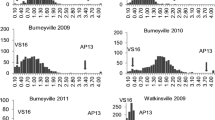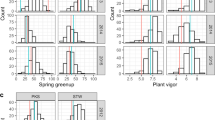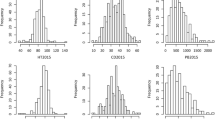Abstract
Genetic and genomic resources have recently been developed for the bioenergy crop switchgrass (Panicum virgatum). Despite these advances, little research has been focused on identifying genetic loci involved in natural variation of important bioenergy traits, including biomass. Quantitative trait locus (QTL) mapping is typically used to discover loci that contribute to trait variation. Once identified, QTLs can be used to improve agronomically important traits through marker-assisted selection. In this study, we conducted QTL mapping in Austin, TX, USA, with a full-sib mapping population derived from a cross between tetraploid clones of two major switchgrass cultivars (Alamo-A4 and Kanlow-K5). We observed significant among-genotype variation for the vast majority of growth, morphological, and phenological traits measured on the mapping population. Overall, we discovered 27 significant QTLs across 23 traits. QTLs for biomass production colocalized on linkage group 9b across years, as well as with a major biomass QTL discovered in another recent switchgrass QTL study. The experiment was conducted under a rainout shelter, which allowed us to examine the effects of differential irrigation on trait values. We found very minimal effects of the reduced watering treatment on traits, with no significant effect on biomass production. Overall, the results of our study set the stage for future crop improvement through marker-assisted selection breeding.




Similar content being viewed by others
References
Schmer MR, Vogel KP, Mitchell RB, Perrin RK (2008) Net energy of cellulosic ethanol from switchgrass. Proc Natl Acad Sci U S A 105:464–469
Parrish DJ, Casler MD, Monti A (2012) The evolution of Switchgrass as an energy crop. In: Monti A (ed) Switchgrass. Springer, London, pp 1–28
FAPRI (2012) World agricultural outlook database; Food and Agricultural Policy Research Institute: Ames, IA, 2012; http://www.fapri.iastate.edu/outlook/2012/. Accessed 18 Aug 2014
Wang MQ, Han J, Haq Z, Tyner WE, Wu M, Elgowainy A (2011) Energy and greenhouse gas emission effects of corn and cellulosic ethanol with technology improvements and land use changes. Biomass Bioenerg 35:1885–1896
Yang Y, Bae J, Kim J, Suh S (2012) Replacing gasoline with corn ethanol results in significant environmental problem-shifting. Environ Sci Technol 46:3671–3678
Michalak AM, Anderson EJ, Beletsky D et al (2013) Record-setting algal bloom in Lake Erie caused by agricultural and meteorological trends consistent with expected future conditions. Proc Natl Acad Sci U S A 110:6448–6452
Hultquist SJ, Vogel KP, Lee DJ, Arumuganathan K, Kaeppler S (1996) Chloroplast DNA and nuclear DNA content variations among cultivars of switchgrass, Panicum virgatum L. Crop Sci 36:1049–1052
Missaoui AM, Paterson AH, Bouton JH (2005) Investigation of genomic organization in switchgrass (Panicum virgatum L.) using DNA markers. Theor Appl Genet 110:1372–1383
Missaoui AM, Paterson AH, Bouton JH (2006) Molecular markers for the classification of switchgrass (Panicum virgatum L.) germplasm and to assess genetic diversity in three synthetic switchgrass populations. Genet Resour Crop Ev 53:1291–1302
Narasimhamoorthy B, Saha MC, Swaller T, Bouton JH (2008) Genetic diversity in switchgrass collections assessed by EST-SSR markers. Bioenerg Res 1:136–146
Zalapa JE, Price DL, Kaeppler SM, Tobias CM, Okada M, Casler MD (2011) Hierarchical classification of switchgrass genotypes using SSR and chloroplast sequences: ecotypes, ploidies, gene pools, and cultivars. Theor Appl Genet 122:805–817
Morris GP, Grabowski PP, Borevitz JO (2011) Genomic diversity in switchgrass (Panicum virgatum): from the continental scale to a dune landscape. Mol Ecol 20:4938–4952
Lu F, Lipka AE, Glaubitz J, Elshire R, Cherney JH, Casler MD, Buckler ES, Costich DE (2013) Switchgrass genomic diversity, ploidy, and evolution: novel insights from a network-based SNP discovery protocol. PLoS Genet 9:e1003215
Okada M, Lanzatella C, Saha MC, Bouton J, Wu RL, Tobias CM (2010) Complete switchgrass genetic maps reveal subgenome collinearity, preferential pairing and multilocus interactions. Genetics 185:745–760
Serba D, Wu L, Daverdin G, Bahri BA, Wang X, Kilian A, Bouton JH, Brummer CE, Saha MC, Devos KM (2013) Linkage maps of lowland and upland tetraploid switchgrass ecotypes. Bioenerg Res 6:953–965
Serba D, Daverdin G, Bouton JH, Devos KM, Brummer CE, Saha MC (2015) Quantitative trait loci (QTL) underlying biomass yield and plant height in switchgrass. Bioenerg Res 8:307–324
Liu L, Huang Y, Punnuri S, Samuels T, Wu Y, Mahalingam R (2013) Development and integration of EST–SSR markers into an established linkage map in switchgrass. Mol Breed 32:923–931
Costich DE, Friebe B, Sheehan MJ, Casler MD, Buckler ES (2010) Genome-size variation in switchgrass (Panicum virgatum): flow cytometry and cytology reveal rampant aneuploidy. Plant Genome 3:130–141
Triplett JK, Wang Y, Zhong J, Kellogg EA (2012) Five nuclear loci resolve the polyploid history of switchgrass (Panicum virgatum L.) and relatives. PLoS ONE 7:e38702
Grabowski PP, Morris GP, Casler MD, Borevitz JO (2014) Population genomic variation reveals roles of history, adaptation and ploidy in switchgrass. Mol Ecol 23:4059–4073
Lowry DB, Behrman KD, Grabowski P, Morris GP, Kiniry JR, Juenger TE (2014) Adaptations between ecotypes and along environmental gradients in Panicum virgatum. Am Nat 183:682–692
Markwell J, Osterman JC, Mitchell JL (1995) Calibration of the Minolta SPAD-502 leaf chlorophyll meter. Photosynth Res 46:467–472
R Core Team (2014) R: a language and environment for statistical computing. R Foundation for Statistical Computing, Vienna, Austria. ISBN 3-900051-07-0, http://www.R-project.org/. Accessed 31 Oct 2014
Pinheiro J, Bates D, DebRoy S, Sarkar D, R Core Team (2014) nlme: linear and nonlinear mixed effects models. R package version 3.1-117, URL: http://CRAN.R-project.org/package=nlme. Accessed 1 Apr 2014
Paine CET, Marthews TR, Vogt DR, Purves D, Rees M, Hector A, Turnbull LA (2011) How to fit nonlinear plant growth models and calculate growth rates: an update for ecologists. Methods Ecol Evol 3:245–256
Margarido GRA, Souza AP, Garcia AAF (2007) OneMap: software for genetic mapping in outcrossing species. Hereditas 144:78–79
Doerge RW, Churchill GA (1996) Permutation tests for multiple loci affecting a quantitative character. Genetics 142:285–294
Lander ES, Green P (1987) Construction of multilocus genetic linkage maps in humans. Proc Natl Acad Sci U S A 84:2363–2367
Fields Development Team (2006) Fields: tools for spatial data. National Center for Atmospheric Research, Boulder, CO. URL: http://cran.r-project.org/web/packages/fields/index.html. Accessed 1 June 2014
Broman KW, Wu H, Sen Ś, Churchill GA (2003) R/qtl: QTL mapping in experimental crosses. Bioinformatics 19:889–890
Lowry DB, Logan TL, Santuari L, Hardtke CS, Richards JH, DeRose-Wilson LJ, McKay JK, Sen S, Juenger TE (2013) Expression QTL mapping across water availability environments reveals contrasting associations with genomic features in Arabidopsis thaliana. Plant Cell 25:3266–3279
Liu L, Wu Y (2014) Switchgrass molecular genetics and molecular breeding for bioenergy traits. In: Luo H, Yanqi W, Kole C (eds) Compendium of bioenergy plants: switchgrass. CRC Press, Boca Raton, pp 189–213
Zhang JY, Broeckling CD, Sumner LW, Wang ZY (2007) Heterologous expression of two Medicago truncatula putative ERF transcription factor genes, WXP1 and WXP2, in Arabidopsis led to increased leaf wax accumulation and improved drought tolerance, but differential response in freezing tolerance. Plant Mol Biol 64:265–278
Casler MD, Tobias CM, Kaeppler SM, Buell R, Wang Z, Cao P, Ronald P (2011) The switchgrass genome: tools and strategies. Plant Genome 4:273–282
Casler MD, Vogel KP (2014) Selection for biomass yield in upland, lowland, and hybrid switchgrass. Crop Sci 54:626–636
Aguirre AA, Studer B, Frei U, Lübberstedt T (2012) Prospects for hybrid breeding in bioenergy grasses. Bioenerg Res 5:10–19
Daverdin G, Bahri BA, Wu X, Serba DD, Tobias C, Saha MC, Devos KM (2014) Comparative relationships and chromosome evolution in switchgrass (Panicum virgatum) and its genomic model, foxtail millet (Setaria italica). Bioenerg Res 8:137–151
Lowry DB, Hernandez K, Taylor SH, Meyer E, Logan TL, Chapman JA, Rokhsar DS, Schmutz J, Juenger TE (2015) The genetics of divergence and reproductive isolation between ecotypes of Panicum hallii. New Phyt 205:402–414
Acknowledgments
We would like to especially thank the many volunteers and students that helped to conduct the fieldwork for this project. We also are grateful to John Crutchfield, who made the experiment possible. Charles Swanson (Texas A&M) designed our irrigation system and along with Guy Fipps (Texas A&M) developed our differential irrigation treatment plan. The University of Texas Freshman Research Initiative provided funding for training of undergraduate students that worked on this project. The National Science Foundation provided funding through a Plant Genome Research Program Award (IOS-0922457) to TJ. A US Department of Agriculture National Institute of Food and Agriculture—Agriculture and Food Research Initiative Postdoctoral Fellowship (2011-67012-30696) supported DL during the time that the experiment was conducted. California State University, Monterey Bay, and Michigan State University provided financial support to DL during the period of data analysis and writing of the manuscript.
Author information
Authors and Affiliations
Corresponding author
Electronic supplementary material
Below is the link to the electronic supplementary material.
Figure S1
Irrigation of plants in 2012 was the same across the field through May. Starting in June, odd rows (blue) received more water than even rows (orange). (PDF 235 kb)
Figure S2
Plot of recombination fractions across the 18 linkage groups of the combined outbred map. (PDF 2415 kb)
Figure S3
An example of the removal of spatial structure for data on biomass collected from the Albany mapping population. A) The distribution of raw biomass trait values across the field. B) The predicted distribution of biomass based on spatial effects. C) The residual biomass used for QTL mapping follow the removal of spatial structure. (PDF 2127 kb)
Table S1
R/qtl input files used in this study for QTL mapping. (xlxs 1.02 MB)
Rights and permissions
About this article
Cite this article
Lowry, D.B., Taylor, S.H., Bonnette, J. et al. QTLs for Biomass and Developmental Traits in Switchgrass (Panicum virgatum). Bioenerg. Res. 8, 1856–1867 (2015). https://doi.org/10.1007/s12155-015-9629-7
Published:
Issue Date:
DOI: https://doi.org/10.1007/s12155-015-9629-7




